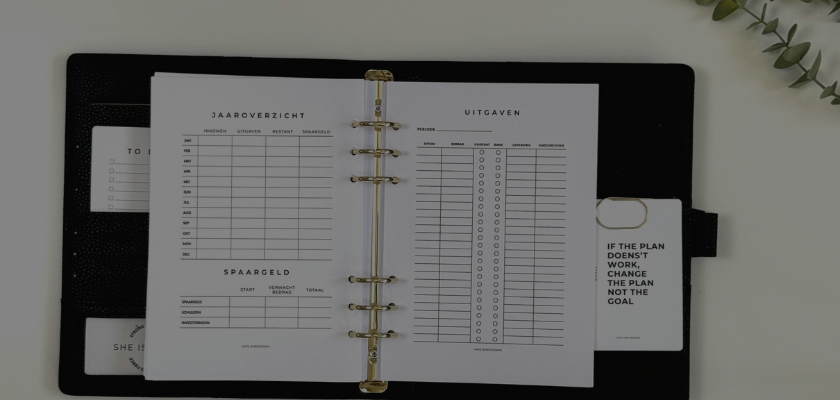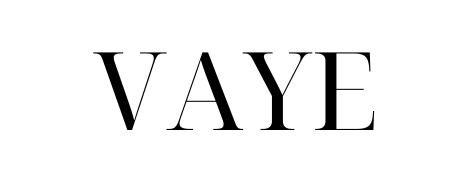
What is a budget booklet and how do you use it?
Share
Every month, that same feeling: you've spent more than you thought, again. But where has that money actually gone? It sometimes feels like your bank account is emptying faster than you realize. Sound familiar? Then a budget planner is exactly what you need.
In this blog post, you'll learn all about what a budget book is, why it works, how to get started, and how to create your own budgeting routine. No boring financial nonsense, just practical tips that will actually help you.
What is a budget booklet?
A budget book is a simple but incredibly useful tool that gives you an overview of your finances. You can use it to:
- to write down your income
- to keep track of your expenses
- to write down savings goals
- and gain insight into your financial habits
You can use a budget notebook as a standalone planner, or combine it with a cash-stuffing folder . The great thing is: you can truly create your own system. Color codes, stickers, trackers—anything is possible.
👉View our budget planners here
Why would you use a budget book?
You might have a banking app or an Excel spreadsheet. Why bother with a physical notebook?
Because writing by hand works. You become more aware of what you spend, you remember it better, and you automatically start thinking more carefully about your habits.
A budget booklet helps you:
- to spend more consciously
- to make savings goals visual
- to recognize unnecessary expenses
- to bring routine into your finances
And the best part? It works. Even if you're not an accountant or planner.
How do you start a budget book?
Getting started doesn't have to be complicated. Just follow these simple steps:
1. Choose a book that suits you
Use a simple notebook or opt for a structured budget planner . At Vaye, you'll find planners already organized into handy categories, with space for savings goals, expenses, and reflection.
2. Collect your income and expenses
Write down what comes in (salary, allowances, additional income) and what your fixed costs are (rent, health insurance, subscriptions).
Then you look at your variable costs: groceries, clothing, outings, transportation, etc. Be honest and don't forget small expenses — they add up quickly.
3. Create categories
Divide your expenses into manageable groups. Consider:
- Groceries
- Transport
- Eating out & coffee
- Presents
- Self-care
- Save
- Emergencies
You can use a cash envelope per category, or simply keep track of them in your book.
4. Set a budget
Figure out how much money you want to spend on each category each week or month. Write it down in your budget book and try to stick to it.
Consider using personalized cash envelopes to visualize your different categories. This makes things clear and more fun to keep track of.
5. Track your expenses
Every time you spend money, write it down in your notebook. It might take you two minutes a day, but it provides a huge amount of insight.
Use expense trackers for a clear overview of what comes in and goes out per envelope or category.
6. Evaluate at the end of the week or month
See what went well and what could be improved. Did you budget too little for groceries? Or do you have some left over in your clothing budget? Adjust it for next month and learn from your own figures.
Tips to keep your budget book full
- Schedule a fixed time (e.g. every Sunday evening) for your budget update
- Combine it with a cash stuffing system
- Use fun accessories to make it fun
- Make your savings goals visible — stick them in your planner or use savings challenges
Frequently asked questions about the budget booklet
Can I combine this with digital banking?
Yes, absolutely. You keep track of your fixed expenses digitally and use your budget book for cash outlays, savings goals, or simply to create an overview.
How much time does it take per week?
On average, about 10 to 15 minutes. Especially at the beginning of the month (for planning) and at the end (for reflection). A daily update takes no more than 2 minutes.
Is this suitable for people who don’t use cash?
Absolutely. You don't necessarily have to work with cash. It's about consciously planning and tracking. Whether you do that with cash or digitally is up to you.
What do you need to get started?
At Vaye Amsterdam, you'll find everything you need to kick-start your budget journey. Whether you want to go all-in with a binder, envelopes, and money boxes, or prefer to start small with a planner and stickers, you can create your own system.
Recommendations:
- Budget booklet or planner
- Cash envelopes (A6 or A5)
- Starter sets for cash stuffing
- Accessories: pens, trackers, stickers
Why you should start today
A budget book is more than just a notebook with numbers. It's your personal guide to clarity, peace, and awareness. Whether you want to save for a vacation, control your spending, or simply finally get a handle on your finances: this is your moment.
Don't wait until January. Start today. Grab a pen, choose your notebook, and write down your first line. You'll thank yourself later.
👉 Check out our collection of budget planners and get started today
